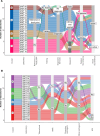Clustering and visualisation of the GABRIEL network expertise in the field of infectious diseases
- PMID: 40379274
- PMCID: PMC12086879
- DOI: 10.1136/bmjgh-2024-017595
Clustering and visualisation of the GABRIEL network expertise in the field of infectious diseases
Abstract
Introduction: The Global Approach to Biology Research, Infectious diseases and Epidemics in Low-income countries (GABRIEL) network is an international scientific network of 21 centres coordinated by the Merieux Foundation (Lyon, France). Mapping and characterising the similarities and differences in expertise and activities across four major infectious diseases (tuberculosis, antimicrobial-resistant infections, acute respiratory infections and emerging pathogens) among these centres would help to provide a better understanding of the network's capacity. It will also highlight how the applied methodology can enhance information sharing within research networks.
Methods: Each centre responded to a questionnaire on their core activities and research themes. An advanced multivariate analysis was performed to relate all items together and highlight new synergies among members of the GABRIEL network. Similarities were found using a clustering algorithm and data were visualised using alluvial plots.
Results: This strategy enabled to find new patterns in the GABRIEL network for the implementation of new projects on global health, regardless of geographical proximity or historical connections. Five clusters based on core activities, consisting of 6, 1, 3, 9 and 2 research units, respectively, have been identified, with clusters 1 and 4, including the majority of the units. Four clusters have been defined based on the four major infectious diseases, comprising 7, 3, 5 and 6 research units, respectively.
Conclusions: The same methodology could also be applied to identify proximities on other networks of experts or between members of different networks for more efficient research or surveillance global programmes.
Keywords: Global Health; Infections, diseases, disorders, injuries.
© Author(s) (or their employer(s)) 2025. Re-use permitted under CC BY-NC. No commercial re-use. See rights and permissions. Published by BMJ Group.
Conflict of interest statement
Competing interests: None declared.
Figures



Similar articles
-
Fogarty International Center collaborative networks in infectious disease modeling: Lessons learnt in research and capacity building.Epidemics. 2019 Mar;26:116-127. doi: 10.1016/j.epidem.2018.10.004. Epub 2018 Oct 23. Epidemics. 2019. PMID: 30446431 Free PMC article. Review.
-
Travel-Related Diagnoses Among U.S. Nonmigrant Travelers or Migrants Presenting to U.S. GeoSentinel Sites - GeoSentinel Network, 2012-2021.MMWR Surveill Summ. 2023 Jun 30;72(7):1-22. doi: 10.15585/mmwr.ss7207a1. MMWR Surveill Summ. 2023. PMID: 37368820 Free PMC article.
-
Infectious diseases in African children.Acta Paediatr Jpn. 1993 Dec;35(6):553-8. doi: 10.1111/j.1442-200x.1993.tb03110.x. Acta Paediatr Jpn. 1993. PMID: 8109240
-
The future of Cochrane Neonatal.Early Hum Dev. 2020 Nov;150:105191. doi: 10.1016/j.earlhumdev.2020.105191. Epub 2020 Sep 12. Early Hum Dev. 2020. PMID: 33036834
-
The contribution of international agencies to the control of communicable diseases.Arch Med Res. 2005 Nov-Dec;36(6):731-8. doi: 10.1016/j.arcmed.2005.07.002. Arch Med Res. 2005. PMID: 16216655 Free PMC article. Review.
References
-
- Komurian-Pradel F, Grundmann N, Siqueira MM, et al. Enhancing research capacities in infectious diseases: The GABRIEL network, a joint approach to major local health issues in developing countries. Clin Epidemiol Glob Health. 2013;1:40–3. doi: 10.1016/j.cegh.2012.11.002. - DOI
MeSH terms
LinkOut - more resources
Full Text Sources
Medical
